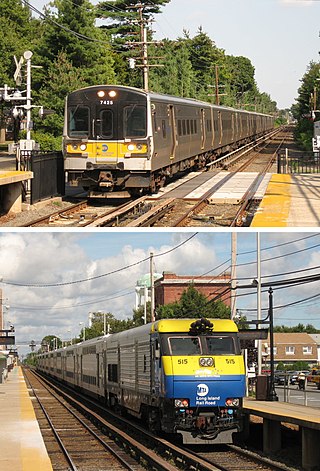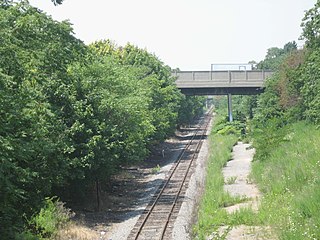
The Long Island Rail Road, often abbreviated as the LIRR, is a commuter rail system in the southeastern part of the U.S. state of New York, stretching from Manhattan to the eastern tip of Suffolk County on Long Island. With an average weekday ridership of 354,800 passengers in 2016, it is the busiest commuter railroad in North America. It is also one of the world's few commuter systems that runs 24/7 year-round. It is publicly owned by the Metropolitan Transportation Authority, which refers to it as MTA Long Island Rail Road. In 2022, the system had a ridership of 70,342,700, or about 253,800 per weekday as of the second quarter of 2023.

A ferry slip is a specialized docking facility that receives a ferryboat or train ferry. A similar structure called a barge slip receives a barge or car float that is used to carry wheeled vehicles across a body of water.

The New York and Atlantic Railway (NY&A) is a short line railroad formed in 1997 to provide freight service over the tracks of the Long Island Rail Road, a public commuter rail agency which had decided to privatize its freight operations. A subsidiary of the Anacostia and Pacific Company, NY&A operates exclusively on Long Island, New York and is connected to the mainland via CSX's line over the Hell Gate Bridge. It also interchanges with New York New Jersey Rail's car float at the 65th Street Yard and US Rail of New York in Yaphank, New York. Its primary freight yard is Fresh Pond Junction in Queens. The NY&A officially took over Long Island Rail Road's freight operations on May 11, 1997. The initial franchise was for 20 years.

A railroad car float or rail barge is a specialised form of lighter with railway tracks mounted on its deck used to move rolling stock across water obstacles, or to locations they could not otherwise go. An unpowered barge, it is towed by a tugboat or pushed by a towboat.

New York New Jersey Rail, LLC is a switching and terminal railroad that operates the only car float operation across Upper New York Bay between Jersey City, New Jersey and Brooklyn, New York. Since mid-November 2008, it has been owned by the Port Authority of New York and New Jersey, which acquired it for about $16 million as a step in a process that might see a Cross-Harbor Rail Tunnel completed.

The Oak Point Link, also known as the South Bronx–Oak Point Link, is a 1.9-mile (3.1 km) long railroad line in the Bronx, New York City, United States, along the east bank of the Harlem River. It connects the Metro-North Railroad's Hudson Line with the Harlem River Intermodal Yard and the CSX Transportation Oak Point Yard at the north end of the Hell Gate Bridge.

The Port of New York and New Jersey is the port district of the New York-Newark metropolitan area, encompassing the region within approximately a 25-mile (40 km) radius of the Statue of Liberty National Monument.
The Cross-Harbor Rail Tunnel is a proposed freight rail transport tunnel under Upper New York Bay in the Port of New York and New Jersey between northeastern New Jersey and Long Island, including southern and eastern New York City.

The Bay Ridge Branch is a rail line owned by the Long Island Rail Road (LIRR) and operated by the New York and Atlantic Railway in New York City. It is the longest freight-only line of the LIRR, connecting the Montauk Branch and CSX Transportation's Fremont Secondary at Glendale, Queens with the Upper New York Bay at Bay Ridge, Brooklyn.
The Long Island Rail Road is a railroad owned by the Metropolitan Transportation Authority in the U.S. state of New York. It is the oldest United States railroad still operating under its original name and charter. It consolidated several other companies in the late 19th century. The Pennsylvania Railroad owned the Long Island Rail Road for the majority of the 20th century and sold it to the State in 1966.

The 69th Street Transfer Bridge, part of the West Side Line of the New York Central Railroad, was a dock for car floats which allowed the transfer of railroad cars from the rail line to car floats which crossed the Hudson River to the Weehawken Yards in New Jersey. Its innovative linkspan design kept the boxcars from falling into the river while being loaded.
The Brooklyn Eastern District Terminal was a shortline railroad and marine terminal with its main facilities and administrative offices located on 86–88 Kent Avenue in the Williamsburg section of Brooklyn, New York City.

The Selkirk Hurdle is the term used by urban planners, railroad employees, politicians, and others to describe the route that must be taken by freight trains traveling between New York City and other points in downstate New York that are east of the Hudson River, and locations in the United States to the south and west. There are no rail freight bridges or tunnels that cross the Hudson River south of Selkirk, which is 10 miles (16 km) south of Albany and the home of Selkirk Yard, a major CSX classification yard. As a result, trains from Long Island and New York City must travel 140 miles (230 km) north to cross at Selkirk before continuing on their way. Advocates claim that this detour and the inefficiencies that result force New York City to rely more heavily on relatively-inefficient trucks than most parts of the United States, where freight trains are more common. However, at least for traffic to and from the west, this route was touted for its efficiency as the "Water Level Route" by the New York Central Railroad because trains using it did not have to climb over the Appalachian Mountains, and it is still used by the New York Central's successor, CSX, for traffic to both sides of the Hudson River.
Greenville Yard is a freight rail yard in the Port of New York and New Jersey. It is located on Upper New York Bay in Jersey City, New Jersey, adjacent and north of Port Jersey. Originally developed in 1904 by the Pennsylvania Railroad, it was later taken over by Conrail. It has been owned by the Port Authority of New York and New Jersey since 2010. It takes its name from the former municipality of Greenville, now part of the city.

The Staten Island Tunnel is an abandoned, incomplete railway/subway tunnel in New York City. It was intended to connect railways on Staten Island to the BMT Fourth Avenue Line of the New York City Subway, in Brooklyn, via a new crossing under the Narrows. Planned to extend 10,400 feet (3,200 m), the tunnel would have been among the world's longest at the time of its planning, in the late 19th and early 20th centuries.

From the start of railroading in America through the first half of the 20th century, New York City and Long Island were major areas for rail freight transportation. However, their relative isolation from the mainland United States has always posed problems for rail traffic. Numerous factors over the late 20th century have caused further declines in freight rail traffic. Efforts to reverse this trend are ongoing, but have been met with limited success.

Fresh Pond Junction is a freight yard in the Ridgewood and Glendale neighborhoods of Queens, New York City. It is operated by the New York & Atlantic Railway, which serves Long Island, New York using tracks owned by the Long Island Rail Road (LIRR). The yard has been in operation since the early 20th century and is the primary rail freight yard on the island.

ExpressRail is a network of on- or near-dock rail yards supporting intermodal freight transport at the major container terminals of the Port of New York and New Jersey. The development of dockside trackage and rail yards for transloading has been overseen by the Port Authority of New York and New Jersey, which works in partnership with other public and private stakeholders. As of 2019, four ExpressRail facilities were in operation, with a total built capacity of 1.5 million lifts.

















